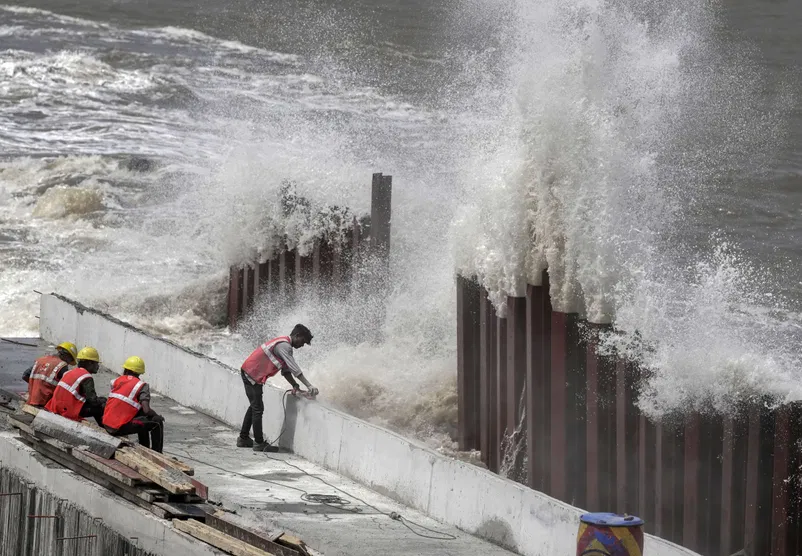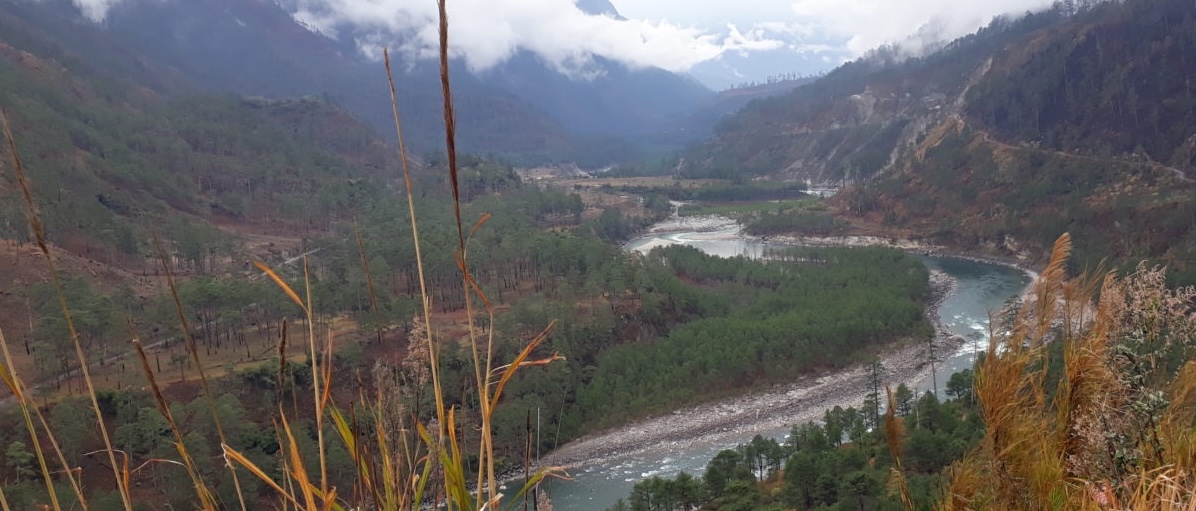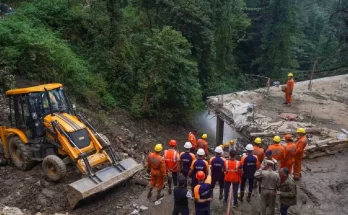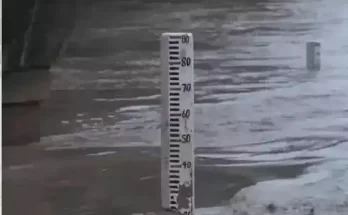Likely to be launched in November, the Common Alerting Protocol system is aimed at saving lives, livestock, and property.

Construction workers at Marine Drive as high tidal waves lash the shore ahead of the landfall of Cyclone Biparjoy in Mumbai on June 15. (Credit: PTI Photo)
New Delhi: When visuals of hundreds of tourists stuck in the Himalayan states during extremely heavy rains flooded the national television screens, many asked whether such eventuality could have been avoided. Incidentally, in early July, the damage and loss of life was almost nil ahead of, during, and soon after the Extremely Severe Cyclone Biparjoy hit the Gujarat coast.
This shows that despite India’s early warning system, when it comes to its dissemination of such information, much needs to be improved.
To this end, the National Disaster Management Authority (NDMA) will soon launch a pan-India Common Alerting Protocol (CAP)-based integrated alert system that will provide early warning for a specified disaster for any given geographical location, disseminated through every available media platform.
These platforms would include cell broadcast, radio, TV, siren, social media, web portal and mobile application. For instance, cell broadcast will include a message flashing on your mobile screen, whether in use or not. If you are watching TV, your TV screens will also flash an alert. On radio, the broadcast will be stopped to give you the alert.
Multiple agencies have been roped in to disseminate the important early warning message, including the National Highways Authority of India, the Indian Railways, and even Google.
This move gains greater importance in light of the Global Report on Internal Displacement (GRID) 2023 released in May, which showed how with 25,07,000 internally displaced persons, India ranked fourth among the total 32.6 million people internally displaced due to natural disasters in 2022.
As high as 98% of disaster displacements were triggered by weather-related hazards such as floods, storms and droughts, even as six out of 10 disaster displacements were triggered by floods, surpassing storms for the first time since 2016, the report said.
What is CAP & how does it work?
CAP defines a standard message format which contains all relevant details such as the type of hazard, its intensity, duration, area of impact, actions to be taken, etc. The CAP has been developed by the Centre for Development of Telematics (C-DOT) for effective disaster management.
“We have one of the best Early Warning Systems (EWS) in the world. The problem is, it doesn’t reach the people at the right time. You have to subscribe to an app, or enter into an SMS group or email group to get alerts. This is not desirable. If the government has got an alert on a particular weather phenomenon, everybody in that particular area should get a message. That is what is called a Common Alerting Protocol,” Kunal Satyarthi, Joint Secretary and Advisor (Policy & Plan), NDMA, told News9 Plus.
There are multiple alert generating agencies such as the India Meteorological Department (IMD), Central Water Commission (CWC) for flood forecast, Indian National Centre for Ocean Information Services (INCOIS) for tsunami and coastal flooding, Defence Geoinformatics Research Establishment (DGRE) for avalanche warning, and the Forest Survey of India (FSI) for forest fires.
All of them put their respective alerts on one common, centralised platform in Delhi. It will be analysed, and then that particular state government, say Kerala or Assam, will be given the specific alert. For instance, Assam government would be sent a specific message saying: “There is going to be flood in such and such taluk in Dibrugarh district,” Satyarthi said.
“So this system is bringing all the alert generating agencies onto one platform. Then there is the alert authorising agency, with NDMA being one of them. But it is the State Disaster Management Authorities (SDMA) that have to take the lead,” Satyarthi added.
Last step would be the alert disseminating agencies employing multiple media platforms to dish out all relevant hazard early warnings to the specific location, that too, in their local language. “The system is being built up. It is being tested. So whenever these are ready, they would be launched,” he added.
Till now, it was a converged platform for the dissemination of targeted alerts to people in local languages through SMS. People in Delhi-NCR have been successfully getting such SMS for months now. Soon, these early warning messages will be disseminated all over the country via available communication media.
“With these new features such as cell broadcast, this could be launched in November. But no fixed date has been decided yet,” said another NDMA official.
Earlier in July, the Department of Telecommunications, Ministry of Communications, had announced that the cell broadcast alert system would enhance emergency communication during disasters and ensure the safety and well-being of citizens.
It had been conducting tests of cell broadcast alert system on each telecom service provider. “These tests will be performed from time to time in various regions across country to gauge the efficiency and effectiveness of emergency alert broadcasting capabilities of the systems in place, of various mobile operators and cell broadcast system,” it had said.
The system is a state-of-the-art technology that allows sending critical and time-sensitive messages for disaster management to all mobile devices within a designated geographical area, irrespective of whether the recipients are residents or visitors.
WMO’s Mission Early Warnings for All in five years
As per a recent answer by the Ministry of Home Affairs pertaining to a question in Parliament about natural disasters, the ministry had listed out details of losses and damages due to hydro-meteorological disasters, including cyclones, floods during the year 2023-24 (as on July 26, 2023). Across India, as many as 1,224 people had lost their lives, 25,558 livestock died, 61,136 houses or huts were washed away/damaged and a whopping 4,04,676.54 hectare crop area was affected during the time mentioned, the ministry said.
Pointing out that with human-induced climate change leading to more extreme weather conditions, the need for early warning systems is more crucial than ever, the World Meteorological Organization (WMO) had launched the ‘Early Warnings For All in next five years’ initiative in 2022.
Early warning systems are not a luxury but a cost-effective tool that saves lives, reduces economic losses, and provides a nearly tenfold return on investment, the WMO had said, and added, “Early warning systems have helped decrease the number of deaths resulting from hazardous weather, water, or climate events.”
The Global Commission on Adaptation had said that giving just 24 hours notice of an impending hazardous event can reduce the damage by 30%.
(This story first appeared on news9live.com on Aug 11, 2023 and can be read here.)



